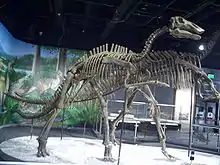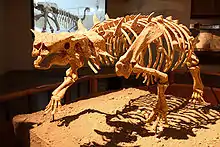1933 in paleontology
Paleontology or palaeontology is the study of prehistoric life forms on Earth through the examination of plant and animal fossils.[1] This includes the study of body fossils, tracks (ichnites), burrows, cast-off parts, fossilised feces (coprolites), palynomorphs and chemical residues. Because humans have encountered fossils for millennia, paleontology has a long history both before and after becoming formalized as a science. This article records significant discoveries and events related to paleontology that occurred or were published in the year 1933.
| |||
|---|---|---|---|
Plants
Angiosperms
| Name | Novelty | Status | Authors | Age | Unit | Location | Notes | Images |
|---|---|---|---|---|---|---|---|---|
|
lodes multireticiilata[2] |
Sp nov |
valid |
An icacinaceous species. |
|||||
|
Langtonia[2] |
Gen et sp nov |
valid |
A tupelo relative, |
|||||
|
Palaeophytocrene[2] |
Gen et sp nov |
valid |
An icacinaceous relative. |
|||||
|
Tinomiscoidea[2] |
Gen et sp nov |
valid |
A moon seed relative. |
|||||
Arthropods
Conodonts
Newly named conodonts
| Name | Novelty | Status | Authors | Age | Unit | Location | Notes | Images |
|---|---|---|---|---|---|---|---|---|
|
Sp nov |
valid |
420 Millions of years ago | ||||||
|
Gen nov |
valid |
Harris and Hollingsworth |
||||||
|
Gen nov |
valid |
Harris and Hollingsworth |
||||||
Archosauromorphs
- Barnum Brown prospected the Two Medicine Formation, but found nothing significant.[5]
- Lull published a monograph where he discusses AMNH 5244, a ceratopsian braincase.[6]
Newly named dinosaurs
Data courtesy of George Olshevsky's dinosaur genera list.[7]
| Name | Status | Authors | Age | Unit | Location | Notes | Images | |
|---|---|---|---|---|---|---|---|---|
| Alectrosaurus[8] | Valid taxon |
late Campanian-early Maastrichtian |
||||||
|
Valid taxon |
late Albian-early Cenomanian |
|||||||
| Bactrosaurus[8] | Valid taxon |
late Campanian-early Maastrichtian |
A hadrosauroid. |
|||||
| Coeluroides[10] | Nomen dubium |
late Maastrichtian |
An Abelisaur. |
|||||
| Compsosuchus[10] | Valid taxon |
late Maastrichtian |
A noasaurid. |
|||||
| Dryptosauroides[10] | Nomen dubium |
late Maastrichtian |
A noasaurid. |
|||||
| Indosaurus[10] | Valid taxon |
late Maastrichtian |
An abelisaurid. |
|||||
| Indosuchus[10] | Valid taxon |
late Maastrichtian |
An abelisaurid. |
|||||
| Jubbulpuria[10] | Nomen dubium |
late Maastrichtian |
A noasaurid. |
|||||
| Laevisuchus[10] | Nomen dubium |
late Maastrichtian |
A noasaurid. |
|||||
| Mongolosaurus[11] | Nomen dubium |
A titanosaur. |
||||||
| Ornithomimoides[10] | Nomen dubium |
late Maastrichtian |
A noasaurid. |
|||||
| Pinacosaurus[11] | Valid taxon |
middle-late Campanian |
An ankylosaurid. |
|||||
Synapsids
Non-mammalian
| Name | Status | Authors | Discovery year | Age | Unit | Location | Notes | Images |
|---|---|---|---|---|---|---|---|---|
|
Valid |
||||||||
|
Valid |
||||||||
Footnotes
- Gini-Newman, Garfield; Graham, Elizabeth (2001). Echoes from the past: world history to the 16th century. Toronto: McGraw-Hill Ryerson Ltd. ISBN 9780070887398. OCLC 46769716.
- Manchester, S.R. (1994). "Fruits and Seeds of the Middle Eocene Nut Beds Flora, Clarno Formation, Oregon". Palaeontographica Americana. 58: 30–31.
- Engel, M.S.; Ortega-Blanco, J. (2008). "The fossil crown wasp Electrostephanus petiolatus Brues in Baltic Amber (Hymenoptera, Stephanidae): designation of a neotype, revised classification, and a key to amber Stephanidae". ZooKeys. 4: 55–64. doi:10.3897/zookeys.4.49.
- New Pennsylvanian conodonts from Oklahoma. RW Harris and RV Hollingsworth, American Journal of Science, March 1933, series 5, volume 25, no. 147, pages 193-204, doi:10.2475/ajs.s5-25.147.193
- "Previous Work," Trexler (2001); page 300.
- "Introduction," Makovicky (2001); page 244.
- Olshevsky, George. "Dinogeorge's Dinosaur Genera List". Retrieved 2008-08-07.
- Gilmore, C.W. 1933. On the dinosaurian fauna of the Iren Dabasu Formation. Bull. Amer. Mus. Nat. Hist. 67: PP. 23-78.
- Longman, H.A. 1933. A new dinosaur from the Queensland Cretaceous. Mem. Queensland Mus. 10: pp. 131-144.
- Huene, F. von, and C.A. Matley. 1933. The Cretaceous saurischia and ornithischia of the Central Provinces of India. Mem. Geol. Survey India Pabeontol. Indica 21: pp. 1-72.
- Gilmore, C.W. 1933. Two new dinosaurian reptiles from Mongolia with notes on some fragmentary specimens. Amer. Mus. Novitates 679: pp. 1-20
References
- Makovicky, P. J., 2001, A Montanoceratops cerorhynchus (Dinosauria: Ceratopsia) braincase from the Horseshoe Canyon Formation of Alberta: In: Mesozoic Vertebrate Life, edited by Tanke, D. H., and Carpenter, K., Indiana University Press, pp. 243–262.
- Trexler, D., 2001, Two Medicine Formation, Montana: geology and fauna: In: Mesozoic Vertebrate Life, edited by Tanke, D. H., and Carpenter, K., Indiana University Press, pp. 298–309.
.png.webp)


